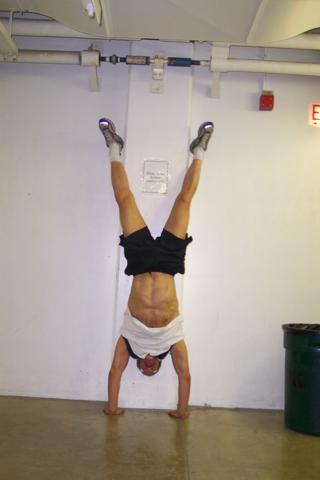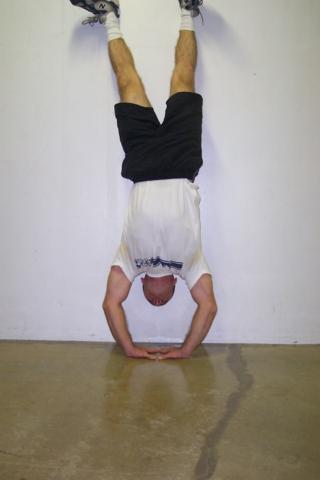Handstand pushups.
Description: Use the body in a full
inversion to practice an overhead press.
Motions trained: Overhead pressing.
Main muscles used: Deltoids and lats
Other muscles: Core
How to do it: Get into a handstand with your arms shoulder width
apart. Lower yourself down
as far as you feel you have control. A narrow grip will ferociously
work the triceps (at right in the pictures).
A wide grip will work the deltoids more than the lats.
How to work up to it: First, take a test to see if you have
sufficient
abdominal strength. Lie on your back and have someone elevate your
feet. Now, see if you can lift your hips off the ground and hold
yourself stiff for 10 seconds. If
you cannot do this, you cannot stabilize upright, so work on this. Next
you need to be
sure that you have been doing enough leg exercises that you can kick
off. You should
be able to do a good 10 double pistols.
You should also be doing overhead presses with dumbbells. Check your
progress with
a machine if you can hold you weight. This is different than lifting
your weight, so have
help getting it up and be sure to keep your back flat against the back
of the seat. This
is where is gets a bit trickier, since some weight machines have your
arms quite far apart,
which is not ideal. You could try a weight bar if you have help.
Now you are ready to point your head at the floor. Try some 'V'
pushups, which is just a pushup
with your feet and hands closer together. Aim for 10 of these. Next try
posting by putting
you knees on a small bench and assuming the position but with your
lower body supported. This will let you practice getting into the
position as safely as possible.
Just practice trying to get up with your hands shoulder width apart and
stay there, without moving, this is called posting. Work up to
posting for a good 30 seconds. Maintain good alignment with the hips
over the shoulders. Get so you can raise one leg
having the other on the bench. When you can post with one leg in the
air for 15
seconds, try raising the other.
Once you can post for a good 15 seconds, you can start to work on
pushups progressively. Get in pushup position with your feet elevated
at 45 degrees. Gradually raise your feet. You can walk your feet up a
wall to do this. You will have to be
able to do a pushup first, of course. Treat handstands and the pushup
parts as independent and
have a goal of integrating them.
Some people find it easier to do this with the tummy against the wall.
To get into this position
by facing the wall, reaching down to one side so you have a twist in
your body, then
pulling your legs up. Smaller lighter people can do this but I
personally never had much success
with it. I usually show folks how to do it with the back to the wall,
then once they are good at
that tell them to give the tummy to the wall version a shot as a
variation.
You do have to grow a lot of new muscle and teach yourself to balance
to do handstands, so don't expect a miracle. On the other hand, it's
like riding a bicycle
and once you have ti down you can rock up into this position in a
heartbeat. I usually
start my workout with a few of these since they feel good. The point is
that there
is a lot more going on here than just raw power in the shoulders.
Again, if you are large and do not have a lot of relative upper body
strength, stick with overhead dumbbell presses and forgo these. A
concussion and dislocated
shoulder(s) aren't worth it.
Ramping it up: Get off the wall. Try to post in the middle of
the room for
up to 30 seconds, then once you can do that on a regular basis, do your
pushups there. You can also practice walking on your hands. This is an
unexpectedly beneficial
exercise, since it requires movement, so your body must accomodate
different angles
and loads. Of course, all of the should be done on mats. Before you
start this
just do a few sommersaults to convince yourself that yes, you can bail
out, then have
fun.
Try them plyometrically: Drop a bit and push off immediately.
Have a friend gently put a hand on your feet to give you added
resistance. This can be increased, but this is fundamentally not a
power movement.
Don't forget to do shrugs when you are inverted. Get into posting
position and without bending your elbows, use you shoulders to move you
up and down. It won't be much, but this is really good
for your shoulder stabilizers. You don't need to do much of this.
Some extremely strong and lightweight people can do these one-handed.
If you think you qualify,
give it a shot. First and foremost, get so you can post for at least 30
seconds to
a minutes before you even think about a one-handed pushup in this
position.
If you are going to do it, start at a corner, so your feet can find
purchase and stabilize you. Shift your balance and root over to
one hand and gradually take the other palm
off the floor, which increases the load on the planted hand. Again,
these are not for everybody by
any means. Work up to it by eventually just being on fingertips with
the assisting hand and
then strive to lift it off the floor just an inch. Pretty gymnastics
form has the free hand at your
side, but this isn't gymnastics.
Do's and don'ts: Don't let your hands get too wide unless you
are very strong indeed.
The wider they are, the more your deltoids do and they might give out
on you with little warning. Also,
hands can slide and the wider they are, the more apt they are to slip.
Concrete feels lousy on your head, so
be careful. Don't use a small mat, even though it looks like it's a
good idea. These can very treacherously slip out from under you.
If you have a large mat securely attached to the floor that might be
ok, but I'd probably opt for a hard floor first.
Don't even think of trying a clapping version of these!
Comments: One of the all time great exercises for your serratus
anterior, which are those little muscles on either side of your
chest that look like ribs. This, as I stated and will do so again, is
not a power move. You should really never plan on having someone over
your head like this for a martial arts technique. It will strengthen
the shoulder
and all the structures that stabilize it.
I started doing these in earnest when I was trying to get over a bout
of back trouble.
I can do these with no ill effect on the lower back (there is no load
it must support),
while overhead pressing machines aggravate it to no end. Some folks
wonder about that.
Once I realized that my bodyweight exercises were giving me a better
workout than weights
and I was largely avoiding any back trouble with them, I dropped the
weights (well
figuratively) and never looked back.





